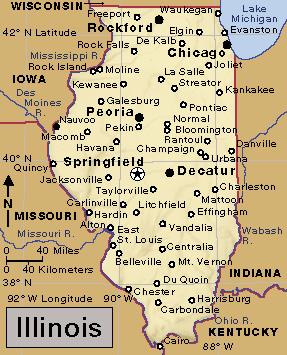Peoria << pee AWR ee uh >> (pop. 113,150; met. area pop. 368,782) is a major industrial center and one of the largest cities in Illinois. It lies in the central part of the state on the Illinois River, about 150 miles (241 kilometers) southwest of Chicago.

Caterpillar, a company that ranks among the world’s major manufacturers of construction equipment, is one of the largest employers in the Peoria area. The health care industry also employs many people in the area. Peoria is the home of the U.S. Department of Agriculture’s National Center for Agricultural Utilization Research.
Peoria’s Lakeview Park features a theater, an aquatic center, an indoor ice-skating arena, and a branch of the Peoria Public Library. A downtown civic center includes an auditorium, convention hall, and sports arena. Peoria RiverFront, a development along the Illinois River, has parks, gardens, sculptures, restaurants, sports facilities, and a museum. Deer, elk, and buffalo roam Wildlife Prairie Park, which lies west of the city. The Peoria area is the home of Bradley University and a branch of the University of Illinois medical school.
The famous question “Will it play in Peoria?” originated in vaudeville days (see Vaudeville). The entertainment industry tested new acts and shows in the city. Peoria later became a test market for consumer products.
The city was named for the Indigenous (native) Peoria people, who originally inhabited the area. The first Europeans to reach the area were Louis Jolliet, a French-Canadian explorer, and Father Jacques Marquette, a French missionary. They arrived by canoe in 1673. A settlement called Fort Crevecoeur was established there in 1680. It was soon abandoned but was followed by several other settlements. The town of Peoria was incorporated in 1835.
Peoria has a council-manager form of government. It is the county seat of Peoria County.
